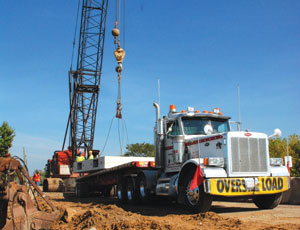Getting stakeholders to agree on a clean-air rule is no easy feat. So it may come as a surprise that the equipment industry is getting behind new federal greenhouse-gas targets for big trucks.

One reason for the lack of debate is economics. “The new, more-efficient trucks will run more cleanly, and their savings at the fuel pump will far outweigh the cost of the technology needed to create those savings,” says Luke Tonachel, a senior analyst at the Natural Resources Defense Council.
Another reason? The needed technology already exists. “The trucking industry supports fuel economy standards that are both economically and technologically feasible as one of several preferred methods in reducing its carbon footprint,” says Brandon Borgna, spokesman for the American Trucking Association.
The U.S. Environmental Protection Agency and National Highway Transportation Safety Administration jointly proposed the new rules in October, targeting trucks in Class 2b through Class 8—everything from heavy-duty pickups to tractor-trailers. These categories were previously unregulated in terms of fuel economy. The regulation would divide the trucks into three groups: Heavy Duty pickups and utility vans, vocational trucks (such as dump trucks and concrete mixers) and combination semi-trailers.
The targets for all these groups focus on fuel economy, which has a direct impact on greenhouse gas emissions, according to environmental experts. The cuts will kick in with the 2014 model year and run through 2018. They are seen as just the first step in improving fuel economy and reducing greenhouse gas emissions from these kinds of heavy vehicles.
The targets would cut heavy-duty pickup and van CO2 emissions by 10% for gasoline engines and 15% for diesels. Vocational trucks would emit 10% less CO2 while increasing fuel economy 20%. Combination trucks would emit 20% less CO2 while using 20% less fuel.
Looking for Payback
Regulators estimate the program would cost $7.7 billion initially but produce $49 billion in benefits for a net gain of $41 billion over the lifetime of the model-year 2014 to 2018 vehicles. The new technology the trucks will need in order to meet the standards would increase the cost of a typical heavy-duty pickup truck by an estimated 4%, the proposal says. For a typical vocational vehicle, the cost bump is an estimated 1% and about 6% more for a typical combination tractor-trailer truck. How those figures will translate to retail prices is a guess at this point.
Despite the anticipated cost increases, the rule could provide payback. Expected fuel efficiency gains ranging from 7% to 20% would pay back most new-truck buyers in one to two years. Buyers whose mileage is considered below daily averages would see payback in four to five years, according to the proposal.
Kevin Healy, equipment procurement manager for contractor Skanska USA Civil Northeast Inc., Whitestone, N.Y., agrees with the rule but would like to see it simplified. “We need to clean up the air, but the rules for doing it should be simpler and clearer,” he says.
Both NRDC and ATA would like to see further steps. “One of the largest opportunities for more savings is to improve trailers, which are not included in this proposal,” says NRDC’s Tonachel. “The technology to boost fuel efficiency with aerodynamic improvements and easier-rolling tires already exists, so it wouldn’t take a lot of lead time for manufacturers to employ it.”
Borgna says that future rules should concentrate on a 65-mph national speed limit for all vehicles, laws allowing more-productive truck weights and combinations that safely improve fuel economy, and improvements to the Interstate highway system that will reduce congestion and cut truck idling time.
The proposed regulation is in the public comment stage until January 31. After that, EPA and NHTSA will analyze the public input, make any adjustments the agencies feel is warranted, and then make the rule final.
| (2008 dollars) Year | HD Pickups and Vans | Vocational | Semi-Tractors |
|---|---|---|---|
2014 | $225 | $374 | $5,896 |
2015 | $292 | $367 | $5,733 |
2016 | $567 | $400 | $5,480 |
2017 | $848 | $392 | $6,150 |
2018 | $1,411 | $359 | $5,901 |
2020 | $1,406 | $343 | $5,661 |
| Source: EPA, NHTSA. Estimated cost per vehicle for producers in 2008 dollars, class 2b through class 8. | |||


Post a comment to this article
Report Abusive Comment